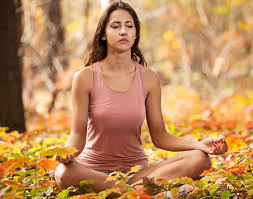We know that Pranayama is a great breathing technique that ensures healthy body and composed mind. Regular practice of various types of Pranayama improves breathing rhythm, cleanses blood, boosts resistance power and improves physical strength. Now let’s understand how to do Pranayama, the guidelines to follow to reap the complete benefit. There are numerous rules and regulations pertaining to Pranayama. Listed below are few guidelines which explains how to do Pranayama.
How to do Pranayama – Guidelines for Pranayama

Time of Practice: The best time to practice pranayama is at the beginning of the day at sunrise, when the body is fresh and mind has very few impressions. If this is not possible another good time is just after sunset. Any Tranquillizing Pranayama can be performed before sleep. As far as possible try to practice regularly at the same time and at the same place every day. Consistency in practice increases mental and physical as well as accustoming the body and mind to the increased pranic force. Do not be in a hurry; relaxed, secure progress is essential.
Place of Practice: Practice in a quiet, clean and pleasant room, which is well ventilated but not draughty. Generally avoid practicing in direct sunlight as the body will become overheated, except at dawn when the soft rays of early morning sun is beneficial. Practicing in a draught or wind, in air-conditioning, or under a fan may upset the body temperature and cause chills.
Sequence for practice: Pranayama should be performed after shatkarmas and yoga asanas, and before meditation practice. Nadi Shodhana Pranayama should be practised in each Pranayama session as its balancing and purifying effects form the basis for successful Pranayama. After practicing Pranayama one may lie down in Shavasana for few minutes.
Seating for practice: A comfortable, sustainable mediation posture is necessary to enable efficient breathing and body firmness during the practice. Siddha Asana or Padmasana are the best postures for Pranayama. The body should be relaxed as possible throughout the practice with the spine, next and head erect. Sit on a folded blanket or cloth of natural fibre to ensure maximum transmission of energy during the practice. Those who cannot sit in the meditation posture may sit against the wall with the legs outstretched or in a chair which has a straight back. Close your Eyelids with eyes pointing towards the tip of the nose. This way, when you close the eyes, the eyes will automatically concentrate on centre point of two eyebrows.
Pranayama Techniques for practice: Lastly adopt the suitable techniques mentioned below to carry out the Pranayama. As you know the Pranayama has three components: the external breath, the internal breath and the steady state breath in between the two. There are many Pranayama breathing techniques involving these components. One can choose pranayama breathing techniques depending on their need like Bhastrika pranayama, Kapalabhati pranayama, Nadi shodana or Anulom vilom pranayama, Ujjayi pranayama, the chosen techniques has to be regularly practiced and this increases and enhances the quantity and quality of prana, clears blocked nadis and chakras, and results very energetic, enthusiastic and positive feeling, When practiced rightly under the right supervision Prananyama brings harmony between the body, mind and spirit, making one physically, mentally and spiritually strong.
Other Guidelines:
Bathing: It would be good to take a bath or shower before commencing the practice, as you can feel very fresh. If not at least wash your hands, face and feet. Do not take a bath at least for half an hour after the practice to allow the body temperature to normalize.
Clothes: Loose, comfortable clothing made of natural fibres should be worn during the practice. The body may be covered with a sheet or blanket when it is cold or to keep insects away.
Empty Stomach: Practice before eating in the morning or wait at least 3-4 hours after meals before starting pranayama. Food in the stomach places pressure on the diaphragm and lungs, making full deep respiration difficult.
Breathing: Always breathe through the nose and not through mouth unless specifically instructed otherwise. Both nostrils must be clear and free flowing before the start of pranayama.
Avoid Strain: With all pranayama practices, it is important to remember that one should not strain, do not try to increase your capacity too fast. It is advised to practice without any strain or discomfort. It is always to follow the expert’s instruction before moving on to a more advanced practice. Furthermore breath retention should be practiced for as long as is comfortable. The lungs are very delicate organs and any misuse can easily cause them injury.
Side Effects: Various symptoms may manifest in normally healthy people. These are caused by the process of purification and the explosion of toxins. Sensation of itching, tingling, heat or cold, and feelings of lightness or heaviness may occur, energy levels may increase or decrease, interests may change. Discuss these experiences with a competent teacher and then continue as per your spiritual teacher’s guidance.
Hope this helped in understanding how to do Pranayama. Follow the guidelines talked above, learn the Pranayama techniques from the expert yoga teacher understand the benefits from each technique. Get regularity in your practice to reap the complete benefits of Pranayama.
- The Namagiri Thayar Mantra – For Wisdom, Creativity & Prosperity - April 29, 2024
- Krishnashtakam – “Krishnam Vande Jagadgurum” – Lyrics & Meaning - April 4, 2024
- Karadarshanam – “Karagre Vasate Lakshmi” – Meaning & Benefits - March 26, 2024


0 Comments